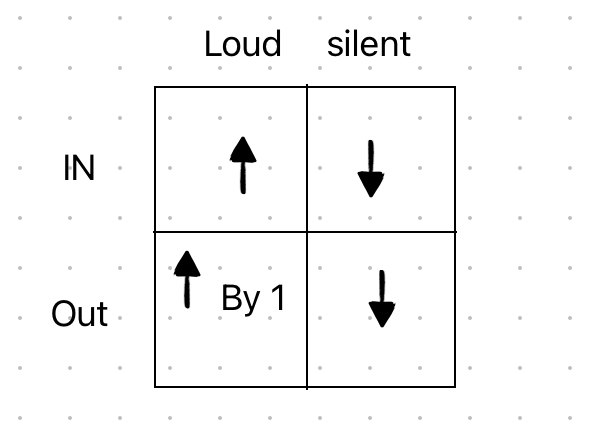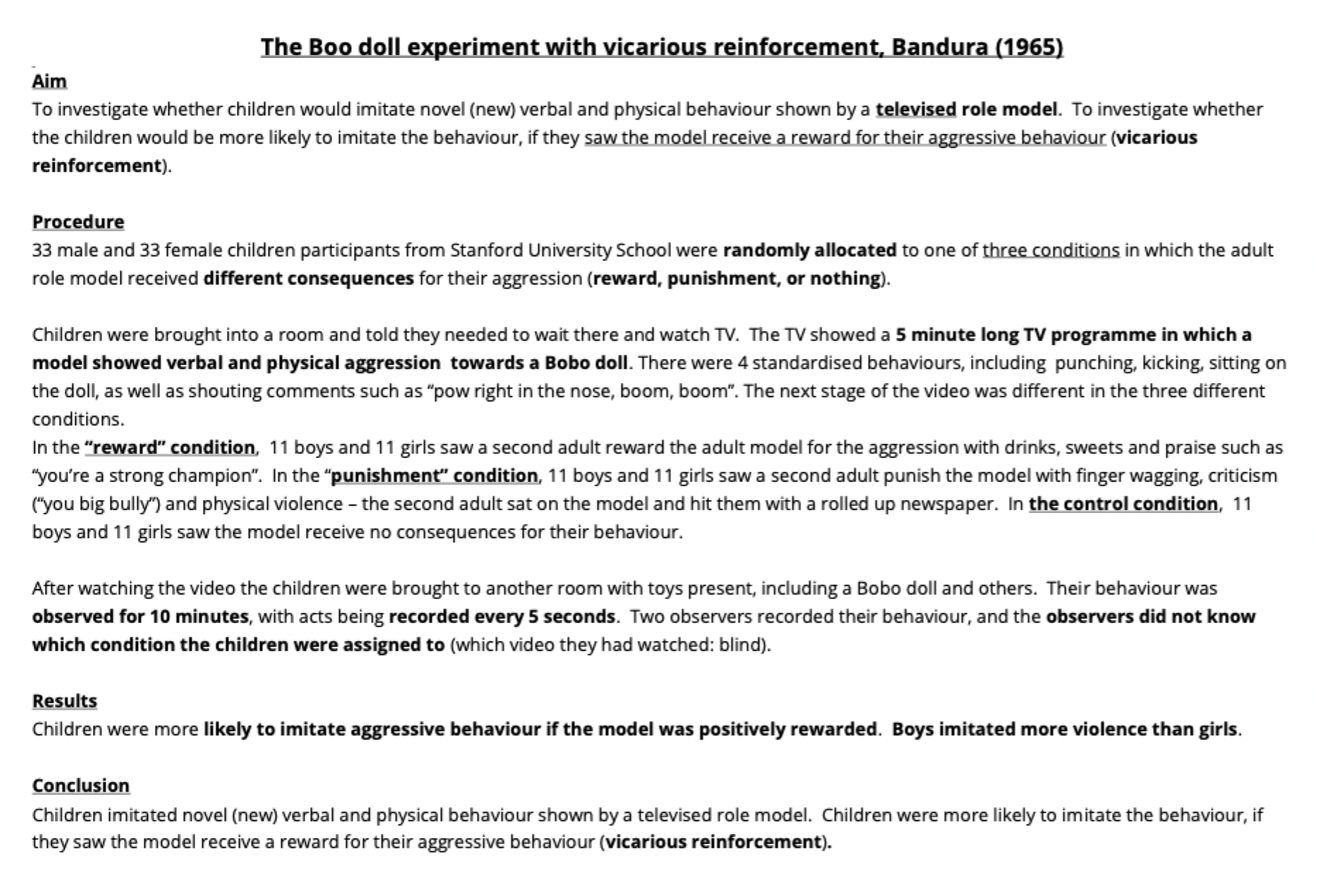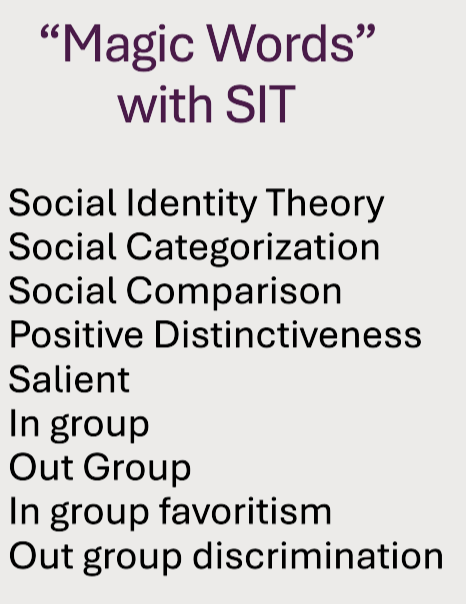Sociocultural ERQ
1/54
Earn XP
Description and Tags
Conformity, SIT, SCT
Name | Mastery | Learn | Test | Matching | Spaced |
|---|
No study sessions yet.
55 Terms
Conformity
Conformity is a change of behavior as a result of real or imagined group pressure and norms
Conformity is the result of?
Social comparison, the tendency to compare ourselves to others around us to validate our behavior
Conformity is the result of which two key factors?
Informational Social influence and normative social influence
Information social influence
One’s need for certainty. So when we are in ambiguous situations we engage in social comparison
Normative social influence
Our need for social acceptance and approval. We conform to be accepted and to fit in, group influence.
Asch - Aim
To test the power of formative social influence on one’s likelihood to conform in a non ambiguous task
Asch - procedure
lab experiment
50 male students
told to be taking part in a vision test
IV: unanimous incorrect response
DV: level of conformity, agreeing with the incorrect response
there was a naive participants and 6 confederates
presented participants with an ambiguous stimulus, on card 1 there was a single line
asked to choose the line on card 2 which was the same length as the first card
6 confederates were instructed to give wrong answers on certain trials and a naive participant alway answered second to last
18 trials - asked to compare the lines 18 times and 12/18 of those times were answered incorrectly
control: 18 trials without the confederates present and only experimenter
then carried out interviews
Asch - Results
12 critical trials - 75% participants conformed at least once
25% never conformed
control = less than 1 % gave the wrong answer
Asch - findings
concluded that one of 3 reasons they conformed
genuinely thought thy were wrong
unsure of answer
didn’t want to be ridiculed
Asch - GRAVE
Validity: done in a lab, no personal connection to the confederates nor the task - lacks mundane realism and has low ecological validity
Credibility: even through the use of interviews, hard to determine why an individual behaved the way they did. no way to know what they were thinking during the experiment only through memory recall
Abrams - aim
To determine if in group identity would affect one’s willingness to conform
Abrams - procedure
independent samples design
included 4 groups
2 independent variables
one
if they were from the in group (psych students)
or out group (history students)
two
if the participants responses were public or private

50 students- 23 males 27 females
3 confederates were introduced either as a first year student from the psych department (in) or history (out)
shown a stimulus line + 3 other lines
asked which was the same length as the stimulus line
identify which of the 3 lines matched the stimulus line
18 trials
9 trials = confederates gave the right response
other 9 = unanimous incorrect response
each session
confederates and one naive participant sat in a row facing the monitor
public condition:
4 members of the group gave their judgements aloud
recorded the real participants response
private condition:
A participant was asked to privately record responses while confederates gave their judgments aloud.
In group
group we identify with, we belong to
out group
the group we don’t belong to
Abrams - results
77% of all paticipants conformed to the wrong confederate judgements on at least one trial
no gender differences
conforming responses was 32%
conformity was the most in in group public condition
least conformity in group private and out group private did not differ

Abrams findings
social categorization plays a role in a decision to conform publicly
less likely to conform when they can do so privately
Abrams GRAVE
validity; low ecological validity
does not mimic naturalistic situation
or high internal validity
high level of control allows us to see a casual relationship between group membership and the DV
rate of conformity to an incorrect response
Generalizability
low generalizability because only used uni students who tend to be
YAVIS: young, affluent, verbal, intelligent, and social
CAPER conformity - reductionist
overlooks the complex interplay of factors such as personal values, emotions, and contextual situational variables.
CAPER conformity - alternative theory
SIT focuses on personal belonging, so intrinsic pressures where conformity focuses on external pressures to seek validation
While conformity theory focuses on external pressures to align with majority norms, SIT posits that individuals conform to strengthen their identification with their social groups, driven by a desire for belonging and self-esteem. This perspective highlights in-group dynamics, suggesting that people may behave in ways that favor their group, thereby resisting conformist pressures from out-groups.
CAPER conformity - practical application
Marketing and Advertising: Understanding how social proof can influence consumer behavior to drive sales.
Education: Employing group dynamics to facilitate learning and teamwork.
Organizational Behavior: Utilizing conformity insights to promote company culture and values.
SIT
Individuals self concept derived from perceived membership of social groups
perceived: what people think of you
associated with the membership of groups we’re part of
What are the two aspects oof social identity?
personal identity
personality, self knowledge, attributes, humor
social identity
self concept from group membership
could be part of personal identity, the values we take in from groups
What are the 3 psychological mechanisms part of SIT?
social categorization, social identification, social comparison/positive distinctiveness
Social categorization
Identifying which groups we belong to
in group = the group we are belonging to other us
out-group is the group we dont belong to the they and them
Social identification
identify with the values and behavior of the group
when social identity becomes personal
values shape who we are, the group is part of us and shapes how we see ourselves
Social comparison/positive distinctiveness
justifying our group membership
seeking positive self esteem
comparing in group to an out group on some dimension to achieve positive distinctness
favor traits of our in group → even groups we didnt choose
Sherif - aim
To study if conflict between groups could be diminished if they worked together on a superordinate goal and to study informal groups and observe the natural and spontaneous developments of group organization attitudes and group norms and realistic conflict theory
Superordinate goal = goals achieved by the contribution and cooperation of two or more people with individual goals that are normally in opposition, working together
What is realistic conflict theory
Groups that are positively independent, working towards common goals, will have good intergroup relations
groups that are negatively independent, in competition for scarce resources will create conflict and ethnocentric attitudes
Sherif - procedure and results
22 boys, aged 11-12
above average intelligence, from stable white protestant middle class homes
field experiment
randomly assigned boys to 2 groups
organized a summer camp with camp staff
collected data by making written records of observed behavior + using cameras and mics
Stage 1: groups were kept separate from each other and played activities to help the group bond and create an identity
chose name for the group
eagles and rattlers
stenciled their team name onto shirts and flags
to establish group identities
Stage 2: researchers introduced conflict through games
one winner and one loser
fight over resources
group delayed getting to a picnic so the other group ate their food
During this stage
name calling
solidarity increased within each group
hostility towards other group
stealing the flag and burning it
established that conflict and negative attitues can arise from group identity and fighting for resources
2 day cooling off period
asked to list features of the two groups
characterized their own in group in favorable terms
out group in unfavorable terms
Stage 3: series of situations to make the boys work together, both groups
camp truck was breaking down
cooperate to pull the truck
Results: superordinate goals eased the tension between groups
no longer intergroup hostility
Sherif - findings
revealed how intergroup conflict and negative intergroup attitudes emerge
confirmed that conflict stemmed from social identity
holds in group biases, in group > out group
Sherif - GRAVE
Validity: field experiment, high ecological validity because it was in a naturalistic setting, however the experimenters could not control extraneous variables like private convos so it also had low internal validity
Ethical concerns - deception used about the fake summer camp. Not protected from physical and psychological harm. Symptoms of anxiety + hostility from other group.
Practical Application - SIT
SIT in theory and research can be applied in the real world.
The salience of these group identities can impact behavior and interactions. For example,
in the workplace, the salience of an employee’s gender or ethnicity may influence team dynamics and collaboration.
In political movements, activists often highlight the salience of a shared identity, such as being part of a marginalized group, to unite supporters.
By understanding the salience of social identities, organizations and leaders can foster inclusivity, reduce conflicts, and promote unity among diverse groups.
Alternative Theory - SIT
Evolutionary:
Early humans who cooperated in groups had better chances of survival through mutual protection, resource sharing, and coordinated hunting.
Over time, natural selection may have favored individuals who were more inclined to form strong group bonds, leading to an innate drive to categorize people into in-groups and out-groups.
Biological:
Additionally, genetic factors may influence traits like empathy, aggression, or group conformity, shaping how individuals interact within social groups.
This perspective suggests that our behaviors are not just learned but also rooted in biological predispositions that shape our group dynamics.
Social Cognitive Theory
Assumes that humans learn behavior through observational learning → people learn by watching models and imitate behavior
theory based on operant conditioning
getting rewarded for doing something even it just feels good
What are the four things that SCT says needs to occur for learning to happen?
ARMP
Attention
Retention
Motivation
Potential
Attention
paying attention to the model
things that could help and depend on
the attractiveness of the model
could be an authority figure
desirability of behavior
Retention
The learner must be able to remember what is observed
Motivation
outcome expectations
wanting to do what was observed
understand the outcome is behavior is repeated
Consistency
diff situations same behavior
identification
imitate like models
affinity
kind and warm to learner
OCIA
Potential
physically or mentally able to be carrying out behavior
certain level of self efficacy
know you’re capable of doing it
Self efficacy
one’s belief in their ability to succeed accomplishing a task
high = more likely to believe you can master challenges
recover from setbacks easier
Low = fear failure, less likely to try challenges
struggle to recover from setbacks
Bandura and the bobo doll - Aim
To see if children would imitate aggression modeled by an adult and to see if children were more likely to imitate same sex models
Bandura - procedure
36 boys and 36 girls
3-6 years old
divided into groups
3 major conditions
control group
aggressive model
same sex
opposite sex
passive model
same sex
opposite sex
researchers pre tested children and assessed aggressiveness
5 point rating scale
physical verbal and aggression toward inanimate objects
matched pairs design
6 per condition
Stage 1: observing the model
brought into a room with other toys like blocks
non aggressive condition = model ignored the bobo doll (10 minutes)
aggressive condition =
1 minute other toys
9 minutes aggressive to the doll in a scripted way - verbal and physical
standardized acts repeated 3 times
Stage 2: brought to another room and played w toys for 2 minutes then asked to leave
stage 3:
behavior was observed for 20 minutes in a one way mirror
interval sampling - observations at certain time marks
observed for
imitative physical
imitative verbal
imitative non aggressive
3 aggressive behaviors that were not imitations
punching
non imitative physical and verbal
aggressive gunplay
Bandura results
aggressive role model - displayed more physical and verbal
aggressive male = boys 25.8 acts of agg avg
non aggressive male = boy 1.5 acts of agg avg
Boys in control = 2 avg acts
Boys > aggression to agg same sex model than girls
girls more verbal aggression than boys from same sex
aggressive = more likely to show non imitative aggression
Bandura findings
children exposed to an agg model = more likely to display agg behavior
boys more physical and girls more verbal
boys more likely to imitate same sex than girls
GRAVE Bandura
generalizability = only children, small sample size, all of people who had uni professor parents, same household situation possibly or socioeconomic situation, hard to generalize
ethics = exposing children to adult violence, could result in psychological trauma or learnt aggressive behavior
Charlton - aim
To investigate the effects of television on children’s aggression and social behavior
Charlton - procedure
remote island of St Helena
Tv was introduced in 1995
cameras were set up in the playgrounds of two primary schools
behavior of children 3-8 were observed before and after the introduction of television
observed a total of 160 children
content analysis of programs showed little difference in quantity of violence watched in comparison to children in the uk
data triangulation = analysis of videotape, interview data from teachers, parents, and older children
natural experiment
Charlton - results
no increase in antisocial behavior among the children of st helena
low rate of behavioral issues and it did not significantly increase after tv was introduced
even after 5 years of exposure
Charlton - findings
tv does not have a significant impact on aggression or social behavior of children
GRAVE Charlton
natural experiment = high ecological validity, carried out under natural conditions
reliability = hard to replicate because it was a natural experiment + unique conditions of the island not having access to tv
Alternative theory - SCT
Social Cognitive Theory (SCT) does not explain why some individuals are exposed to certain behaviors and have those actions modeled for them, yet do not exhibit the same behavior themselves.
For example, SCT fails to address why someone without the genetic predisposition for aggression, such as low levels of MAOA does not engage in antisocial behavior despite being exposed to aggressive models.
This limitation suggests that SCT does not account for the influence of uncontrollable genetic factors on learning.
Moreover, evolutionary theory presents a challenge to SCT by suggesting that humans may have a biological predisposition for specific behaviors that enhance survival and reproduction.
This perspective indicates that behavior can arise not only from modeled experiences in early childhood but also from inherited biological traits.
Application - SCT
SCT can be applied in fields to understand problematic behavior in both children and adults.
For instance, aggressive behavior can be acquired from growing up in an abusive household or by observing models of aggression.
This can lead to subconscious learning of aggressive actions, which may contribute to an increase in antisocial behavior.
Thus, psychologists and scientists can also use this theory to predict behavior as a result of childhood background or based on the environment that people live in.
Bandura’s bobo TV study - sct

SIT magic words

SCT magic words
